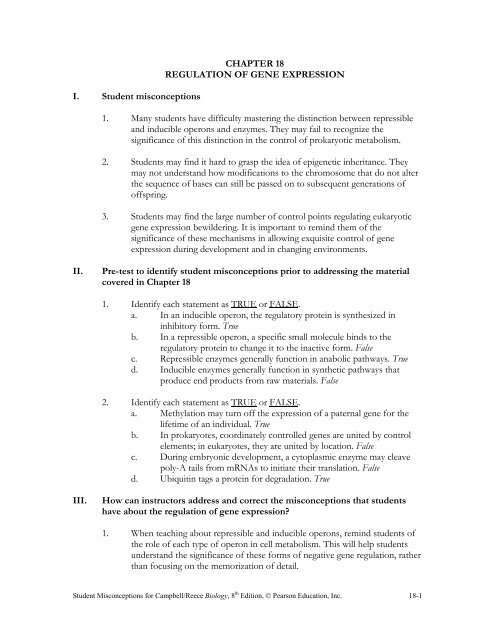CHAPTER 18 REGULATION OF GENE EXPRESSION I. Student ...
CHAPTER 18 REGULATION OF GENE EXPRESSION I. Student ... CHAPTER 18 REGULATION OF GENE EXPRESSION I. Student ...
I. Student misconceptionsCHAPTER 18REGULATION OF GENE EXPRESSION1. Many students have difficulty mastering the distinction between repressibleand inducible operons and enzymes. They may fail to recognize thesignificance of this distinction in the control of prokaryotic metabolism.2. Students may find it hard to grasp the idea of epigenetic inheritance. Theymay not understand how modifications to the chromosome that do not alterthe sequence of bases can still be passed on to subsequent generations ofoffspring.3. Students may find the large number of control points regulating eukaryoticgene expression bewildering. It is important to remind them of thesignificance of these mechanisms in allowing exquisite control of geneexpression during development and in changing environments.II.Pre-test to identify student misconceptions prior to addressing the materialcovered in Chapter 181. Identify each statement as TRUE or FALSE.a. In an inducible operon, the regulatory protein is synthesized ininhibitory form. Trueb. In a repressible operon, a specific small molecule binds to theregulatory protein to change it to the inactive form. Falsec. Repressible enzymes generally function in anabolic pathways. Trued. Inducible enzymes generally function in synthetic pathways thatproduce end products from raw materials. False2. Identify each statement as TRUE or FALSE.a. Methylation may turn off the expression of a paternal gene for thelifetime of an individual. Trueb. In prokaryotes, coordinately controlled genes are united by controlelements; in eukaryotes, they are united by location. Falsec. During embryonic development, a cytoplasmic enzyme may cleavepoly-A tails from mRNAs to initiate their translation. Falsed. Ubiquitin tags a protein for degradation. TrueIII.How can instructors address and correct the misconceptions that studentshave about the regulation of gene expression?1. When teaching about repressible and inducible operons, remind students ofthe role of each type of operon in cell metabolism. This will help studentsunderstand the significance of these forms of negative gene regulation, ratherthan focusing on the memorization of detail.Student Misconceptions for Campbell/Reece Biology, 8 th Edition, © Pearson Education, Inc. 18-1
I. <strong>Student</strong> misconceptions<strong>CHAPTER</strong> <strong>18</strong><strong>REGULATION</strong> <strong>OF</strong> <strong>GENE</strong> <strong>EXPRESSION</strong>1. Many students have difficulty mastering the distinction between repressibleand inducible operons and enzymes. They may fail to recognize thesignificance of this distinction in the control of prokaryotic metabolism.2. <strong>Student</strong>s may find it hard to grasp the idea of epigenetic inheritance. Theymay not understand how modifications to the chromosome that do not alterthe sequence of bases can still be passed on to subsequent generations ofoffspring.3. <strong>Student</strong>s may find the large number of control points regulating eukaryoticgene expression bewildering. It is important to remind them of thesignificance of these mechanisms in allowing exquisite control of geneexpression during development and in changing environments.II.Pre-test to identify student misconceptions prior to addressing the materialcovered in Chapter <strong>18</strong>1. Identify each statement as TRUE or FALSE.a. In an inducible operon, the regulatory protein is synthesized ininhibitory form. Trueb. In a repressible operon, a specific small molecule binds to theregulatory protein to change it to the inactive form. Falsec. Repressible enzymes generally function in anabolic pathways. Trued. Inducible enzymes generally function in synthetic pathways thatproduce end products from raw materials. False2. Identify each statement as TRUE or FALSE.a. Methylation may turn off the expression of a paternal gene for thelifetime of an individual. Trueb. In prokaryotes, coordinately controlled genes are united by controlelements; in eukaryotes, they are united by location. Falsec. During embryonic development, a cytoplasmic enzyme may cleavepoly-A tails from mRNAs to initiate their translation. Falsed. Ubiquitin tags a protein for degradation. TrueIII.How can instructors address and correct the misconceptions that studentshave about the regulation of gene expression?1. When teaching about repressible and inducible operons, remind students ofthe role of each type of operon in cell metabolism. This will help studentsunderstand the significance of these forms of negative gene regulation, ratherthan focusing on the memorization of detail.<strong>Student</strong> Misconceptions for Campbell/Reece Biology, 8 th Edition, © Pearson Education, Inc. <strong>18</strong>-1
2. Explaining some of the fascinating examples of epigenetic inheritance,including the effects of imprinting in human development, may motivatestudents to gain a clearer understanding of this concept. Haig (1993)discusses how genetic conflict and imprinting contribute to many of theproblems with human pregnancy, including pre-eclampsia and gestationaldiabetes.3. Illustrate the coordinate control of gene expression in eukaryotes bydescribing the activation of related genes that are stimulated by a particularhormone. The text describes the monthly cycle of activation by estrogen of agroup of genes, stimulating cell division in uterine cells to prepare the uterusfor pregnancy.IV.Post-test to identify whether students have corrected their misconceptions1. Illustrating your explanation with suitable examples, explain why repressibleenzymes generally function in anabolic pathways, whereas inducible enzymesusually function in catabolic pathways.2. Using an example of activation by a steroid hormone, explain how geneexpression in a eukaryotic cell can be coordinately controlled.3. Explain how the translation of mRNAs stored in the cytoplasm duringoogenesis may be initiated following fertilization.V. ReferenceHaig, D. (1993). Genetic conflicts in human pregnancy. Quarterly Review of Biology, 68,495–532.<strong>Student</strong> Misconceptions for Campbell/Reece Biology, 8 th Edition, © Pearson Education, Inc. <strong>18</strong>-2



